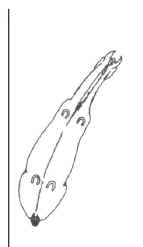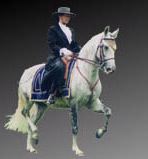 |
classicaldressagescotland.com |
| Lesson 15: Starting Lateral Work: The Shoulder-in |
| New web address: www.classicaldressagescotland.com |  |
| About this site | About us | Personal Tuition | Video analysis | Lesson menu | Portugal and Lusitanos |
| Home Schooling Classical dressage Modern dressage Horse trials Show jumping Glossary Links |
The History and Background Bit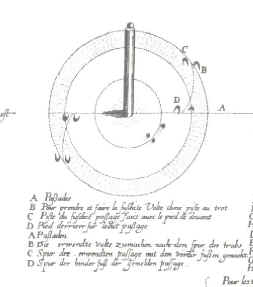 The French court riding master and trainer La Gueriniere is usually credited with
inventing the shoulder-in in the eighteenth century. This was because he
adapted the movement for use on straight lines. However; Pluvinel used the
basic shoulder-in and many other lateral movements earlier during the
seventeenth century. Pluvinel used the exercise especially around the pillar to
increase the horse's suppleness and to get him used to the aids, especially the
leg aids. He felt the exercise helped to make the horse obedient. Independently, the Duke of
Newcastle found the exercise and also used it around the pillar.
The French court riding master and trainer La Gueriniere is usually credited with
inventing the shoulder-in in the eighteenth century. This was because he
adapted the movement for use on straight lines. However; Pluvinel used the
basic shoulder-in and many other lateral movements earlier during the
seventeenth century. Pluvinel used the exercise especially around the pillar to
increase the horse's suppleness and to get him used to the aids, especially the
leg aids. He felt the exercise helped to make the horse obedient. Independently, the Duke of
Newcastle found the exercise and also used it around the pillar.
Since that time it has been found that the shoulder-in is probably the most important suppling, strengthening and preparing exercise that exists for the rider training his horse. The Principle of Shoulder-inThe principle of the shoulder-in is that the horse's footfalls are on three tracks. 1st track - the outside hind. 2nd track - the inside hind and outside fore and the 3rd track the inside fore. The horse is encouraged to bend his body round in front of the inside hind leg so that this hind leg does more than its usual amount of work and is the prime driving limb for propelling the horse along. You are loading the inside hind leg.What Will the Shoulder-in Do For You?Think of the shoulder-in as the basis of all lateral work and the cornerstone of all equine gymnastic exercises. If you can ride a good and correct shoulder-in, your horse should find all the other lateral movements fairly easy. Note from the diagrams that the length bend is the same for all four lateral movements. You do not change bend, you just change direction!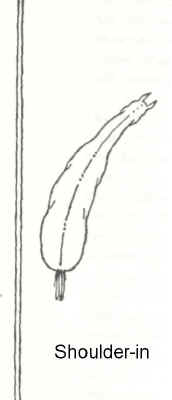
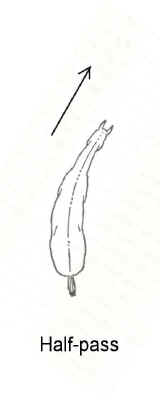
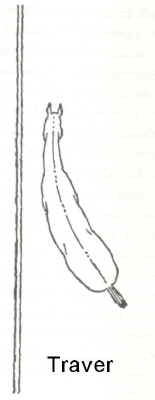

Before you start the shoulder-in there is a little checklist to go through to make sure you and your horse are ready.
The AidsIf you are trotting, sit!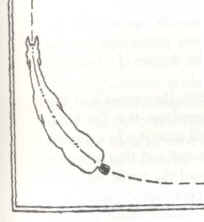
Use a corner or a circle to prepare. This will enable you to get length bend in the horse before the movement. It's more difficult to establish the length bend on a straight line especially if your horse is not used to the movement./
As you come out of the corner or circle, allow the forehand to leave the track. Make sure your shoulders are at the same angle as your horseís shoulders. I prefer to bring my inside shoulder back rather than move my outside shoulder forward. As the forehand comes off the track, catch the forward momentum with the outside rein. At the same time use the inside leg on the girth to keep the horse bent and stop it leaving the track. So you are pushing him along the track from your inside leg into the outside rein. Your outside leg slightly behind the girth is passive. This is really important point. Be as soft as you can with your inside rein. Do not try and hold the horse in position with the inside rein. It just will not work. I like to look diagonally across the school. I use the horse's ears, as you would gun sights. If you are sitting at the correct angle i.e. your shoulders are at the same angle as your horse's and your head is straight (not looking to the right or left) then if the horse's ears are in front of you, you must have the correct angle. Stay supple. The horse needs your body to be totally neutral and giving while he is trying to do a lot of things with his body and legs at the same time. He has his hooves full with the shoulder-in and it will just make the movement more difficult for him if he has to cope with your stiffness. Once you have the shoulder-in position and itís working, do not keep asking for shoulder-in. Just adjust the movement. If you keep asking for the movement as you did in the corner or off the circle, your horse will become confused and try and do something else to avoid the annoying repetition of the same aid. If he is doing it, back off, let him do it. If you ride shoulder-in to the next corner make him straight before the corner. In competition dressage the shoulder-in is normally done from marker to marker. Not corner to corner. Get used to straightening him before the next movement. It's good practice. If however you are going to circle out of the shoulder-in, keep the length bend and use your outside leg to encourage your horse off the track and ride the circle. The Angle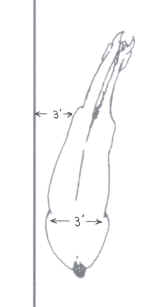 There has always been a lot of argument as to what is the best angle to ask your horse to
perform in shoulder-in. How far should the shoulders be from the track? It
depends on the size and width of your horse. There are a lot of opinions about
this and in my experience the judges are more confused than the riders are. If
you think about it, if the judge is sitting at the C marker watching the
shoulder-in down the long side, itís virtually impossible to see the correct
angle, especially if the horse is going away from the judge towards "A".
There has always been a lot of argument as to what is the best angle to ask your horse to
perform in shoulder-in. How far should the shoulders be from the track? It
depends on the size and width of your horse. There are a lot of opinions about
this and in my experience the judges are more confused than the riders are. If
you think about it, if the judge is sitting at the C marker watching the
shoulder-in down the long side, itís virtually impossible to see the correct
angle, especially if the horse is going away from the judge towards "A".
In competition I used to find out who the judge was and adjust my angle of shoulder-in accordingly. If it was a judge that liked to see a lot of angle and marked you down as "not sufficient" when I rode a correct three-track shoulder-in, I adjusted the movement so that the horse appeared to be at the correct angle through his body but was really on four tracks. If however the judge knew what he or she was doing and not only looked for angle of movement but engagement of hind quarters and purity of the pace, then I would ask for three-track and ride the movement classically and correct. Anyway here is a little exercise so that you will know the correct angle every time and confirms the point that the angle depends of the size and bulk of your horse. Bear in mind that the movement is on three tracks, the outside foreleg must be in line with the inside hindleg. That means that the shoulders should be off the track the same distance as a measurement taken across the horse's rump as per picture I'm not suggesting that you should ride the movement with a ruler, but it will give you a rule of thumb. Just glance down the outside of the horse and judge the distance from the horseís shoulders to the boards or track. If you really want to be picky, position your horse at a standstill at the correct angle and measure the shoulders from the track. Then mount and try to picture in your mindís eye the distance for shoulder to boards when riding. As with all things, practice makes perfect. How to Correct the AngleWhen first starting this exercise, the shoulder-in, the horse will find the extra work difficult and exacting. He will initially be reluctant to give you a true angle in shoulder-in. He will try and avoid the work by leaving his body straight, parallel to the wall or track, and just bend his head and neck. This is also a problem if the rider is using too much inside rein. Itís known in the trade as a horse going perfectly straight with its head cranked to one side. HORRIBLE. If your horse is going forward, either in walk or trot, and you are absolutely certain that you are not holding the inside rein, but he is just not bending through his body, you will have to correct the angle sooner rather than later. To get the correct bend this is what you do. Momentarily take the inside rein in a gesture that says "keep the neck bend". Then half-halt or take the outside rein back towards you in a gesture that says "straighten your neck". At the same time use a little more pressure with the inside leg that says ìdo not leave the trackî. Since your horse cannot straighten his neck because you have hold of the inside rein and he cannot swing his head and neck in front of him, he will move his shoulder in, off the track, to make his neck straight. The instant he has made a correction, back off with the rein and carry on riding him from the inside leg into the outside rein with very little inside rein. If your horse is leg yielding down the track, for example he is straight through his body with no neck bend, is on four tracks but the shoulders are the correct distance off the boards, the most likely cause is that you are asking for bend with your inside leg behind the girth. This gives quarters-out, not shoulder-in. Your inside leg must be on the girth. Even if your horse is going well in shoulder-in and the exercise looks and feels perfectly OK, be careful that you do not ask for bend with your leg behind the girth. There will be no problems when you are in a school with a wall, but wait until you get to a dressage competition and the arena has just a rope or gutters around it. With quarters-out, you will squash the arena markers and the organizers will be extremely upset! The judge will laugh her socks off as well, which will not be good for overall marks. To make sure you are not committing this foul deed, get a friend to watch you shoulder-in down the centerline of the school. Your friend will want to see that the quarters are travelling down the centerline, not the shoulders. Itís good practice anyway to ride the movement away from the boards sometimes. It's good for discipline and stops your horse anticipating. Also you will want to change this shoulder-in into a halfpass at a later stage of training and if your have both legs back, confusion. But more of that at a later stage in the Half-pass lesson. Shoulder-fore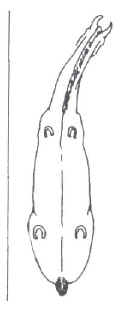
Shoulder-fore is a sort of half shoulder-in that you could use if your horse is very young or very stiff or very dumb. Itís basically riding your horse in a straight line with its head cranked to one side. As you can gather, I am not very keen on this movement, but it does work with some horses, so if it works, how can I knock it?
For a young or stiff horse I prefer to leg yield down the track on four tracks. I find this movement an easier transition from the incorrect movement to the correct exercise and the horse does not seem to get confused when the shoulder-in is gradually introduced. However, shoulder-fore is a recognised movement that you will hear of, so it's only right and fair that I explain it to you. It does help to introduce the movement to your equine friend. It certainly will convince the horse that he can go in a perfectly straight line but with his head and neck not in alignment. And thatís the idea behind the shoulder-fore. It's an introduction. But once again. Train your horse to get off the inside leg, not the inside rein. Just because you are riding shoulder-fore and not shoulder-in, please donít take this as an excuse to hold onto the inside rein. It will make the true movement of shoulder-in almost impossible later on. The basic aids are exactly the same as the shoulder-in but allow the horse to keep his body straight. Just a question of degree and feel. Over a period of time, gradually replace the angle of shoulder-fore with the correct angle of shoulder-in. 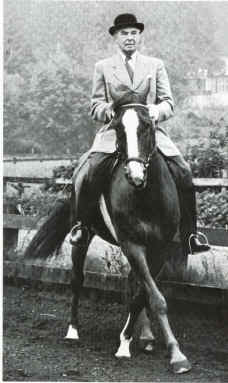
To SummarizeThe shoulder-in is one of the easier movements to achieve if you follow the rules. I'm not saying that the shoulder-in is simple. None of these exercises are simple All I am saying is that in my experience, the horse finds the concept of this movement not the equine equivalent to rocket science. The horse seems to pick up what you want very quickly. But once again I emphasize, you must follow the rules. There are two big problems you will have. First you will be tempted to hold on to the inside rein. Second, you will become tense and stiff. Avoid both of these traits or habits. They will really get in the way of your training and your horse will no doubt go on strike. The following old photograph is of Alois Podhajsky. This picture has appeared on the site before but I make no apologies. It's probably the best photograph of a shoulder-in that exists. Perfect position from both horse and rider. If you guys have a better one, please forward it and I will include it in this lesson. Once again, good luck with the lesson. Have fun but follow the rules and you really wonít have a problem. But as always, if you do have a glitch, send me an e-mail and we will sort it out
|
